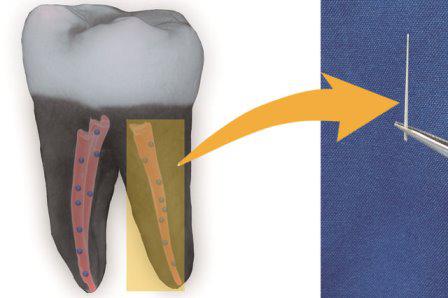Perhaps in the near future, the treatment of pulpitis will have less negative consequences for the patient: scientists from the University of California at Los Angeles have developed a technique that allows increasing the strength of materials used in the process of canal filling using nanodiamonds (or ultrafine diamonds).< /p>

Nanodiamonds are ultra-small particles or diamond dust that remain after diamonds have been turned or mined. The size of such a particle is thousands of times smaller than the diameter of a human hair. At the moment, extensive research is being carried out on the properties of this material and its possible use in dentistry, oncology, regenerative medicine and other fields.
The main task of the dentist is to prevent the spread of infection from the pulp into the root canal. During the procedure, the doctor removes the affected areas of the pulp and fills the resulting place with a polymeric material called gutta-percha. This material is used mainly because it does not react with surrounding tissues. However, if the infection has not been completely removed, then residual infection in the canal can lead to tooth loss.
It should be said that the traditional material for canal filling (gutta-percha) has a number of disadvantages, including: the lack of anti-infective properties and insufficient rigidity.
To overcome the shortcomings of this material, a group of scientists from the University of California developed and tested two types of improved gutta-percha. The first material was enhanced with ultrafine diamonds, and the second was enriched with nanodiamonds with antibiotic particles.
To test the properties of the first material, Department of Dentistry scientists Sue Win Kim and Adelheid Nerysa Limansubroto filled the canals of real teeth using the test material. Next, they took X-ray and micro-computed tomography images of the teeth, as a result of which, it was found that this material is suitable for filling root canals. However, the researchers noticed that, as in the case of canal filling with conventional gutta-percha, the use of material with an improved formula leaves small empty spaces in the root of the tooth, where bacteria can subsequently multiply. However, the results of computed tomography showed that the material with the addition of nanodiamonds also effectively fills the root canal, as well as conventional gutta-percha.
“The satisfactory results of the first stage of the study theoretically allow us to proceed to clinical trials of gutta-percha enriched with nanodiamonds,” says the main author of the work, professor of biology and oral medicine, director of the Center for Reconstructive Biotechnology, prof. Ding Ho.
During the second phase of the study, the scientists tested the properties of the material with nanodiamonds and particles of amoxicillin, a broad-spectrum antibiotic used to treat infections. As tests have shown, ultrafine diamonds with antibiotic particles introduced into gutta-percha effectively inhibit the growth of bacteria.
“Gutta-percha enriched with nanodiamonds acquires the necessary properties, such as improved mechanical characteristics and antibacterial properties, which is necessary to combat with bacterial infections in the root of the tooth,” says Dong Kein Li.
The work involved scientists from the University of California, specializing in various fields: materials science, nanotechnology, drug delivery, toxicology, dental radiology, endodontics, microbiology, etc.
“Thanks to the close-knit work of employees from different fields, the team of prof. Ho intends to change the approach to restorative dentistry,” says Dr. No-Hee Park, Dean of the Department of Dentistry at the University of California and one of the co-authors of the work.
Over the next two years, scientists plan to optimize the formula of gutta-percha enriched with nanodiamonds and start clinical trials of the material at the University of California.
